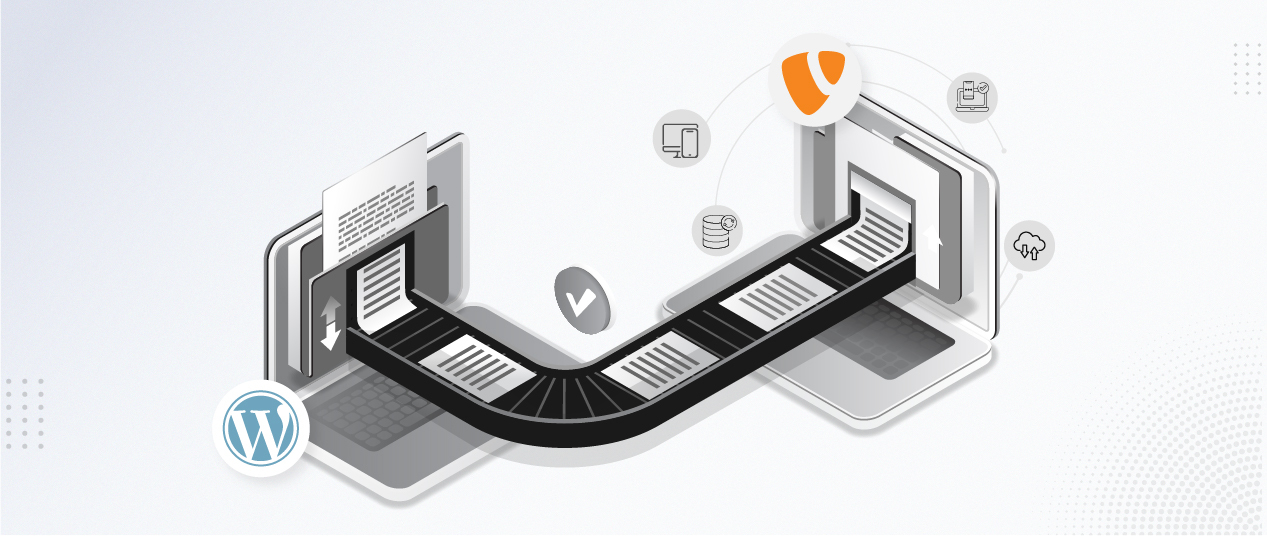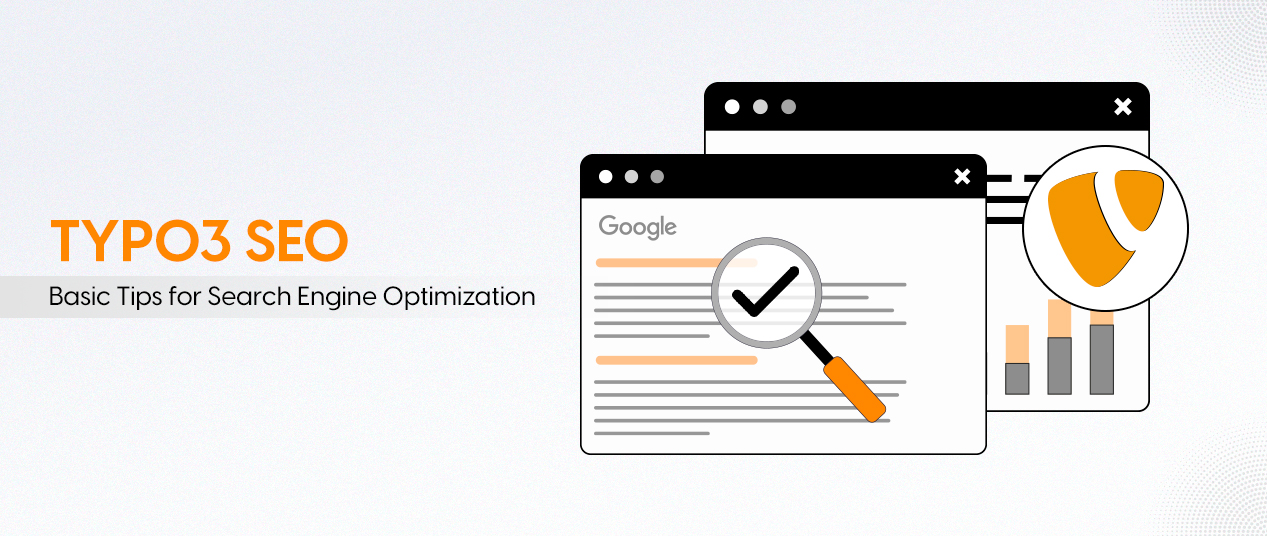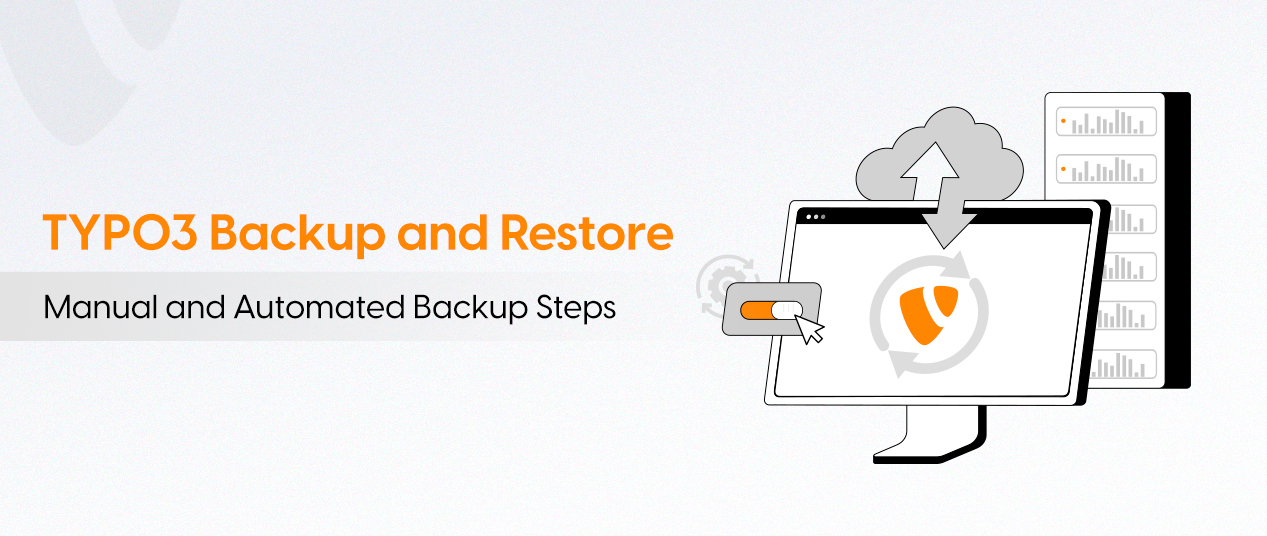Generally, a CMS provides a spotlight that your brand deserves which includes framework, functionalities, web design, web development which helps in thriving your business to growth. Implementing a right CMS for your business helps you to provide personalized customer experiences, traffic management, driving conversions and completing business goals.
Introduction to WordPress and TYPO3 CMS
What is TYPO3?
TYPO3 is an open-source CMS platform that provides a wide range of templates, extensions and multiple community resources which helps in creating a web platform for your business. Using TYPO3 CMS one can create, edit and manage content on your website without having good coding/technical skills. Feature rich TYPO3 CMS provides drag & drop editor and multilingual support which gives you extra wings for managing everything directly from the backend. TYPO3 CMS is built with an enterprise business mindset which includes many useful tools and comes with highest security standards. It also includes inbuilt SEO tools for supporting your marketing of your business website.
What is WordPress?
Wordpress is also an open-source CMS platform which was originally created for blogging. Till the date it has strong roots in blogging, but evolving over time it can create any type of website. As a nature of constantly changing using WordPress needs frequent updating which means business websites prefer less using WordPress.
For more detailed comparison read here: TYPO3 vs WordPress
Limitations of WordPress
You Need Lots of Plugins For Additional Features
When using wordpress CMS you will need lots of extensions and plugins to integrate for adding extra features to your websites. Here the extensions get outdated and you would have to install, manage, and update the plugins on a timely basis and this can be not easy to perform.
Slow Page Speed
WordPress is still a slow CMS platform because of adding extensions, templates and codebases. Page speed of any website is very important as fast loading webpage will elevate customer experience.
Website Vulnerability
Wordpress has disadvantages of website vulnerability as it is the most popular CMS platform so the main target of hackers and spammers is Wordpress CMS. According to a survey WordPress faces about 90,000 attacks per minute. If you download and integrate all the security extensions of WordPress it is not enough to keep your website secure.
Advantages of TYPO3 CMS
- TYPO3 CMS build for Businesses
TYPO3 CMS is suitable for small and large businesses. It is scalable and has workflows as required for enterprises.TYPO3 CMS has a variety of extensions and templates to add extra features in your website. - TYPO3 CMS is OpenSource
The main advantage of using TYPO3 CMS is it is open source and it has access to the code for developing or changing everything you wish to change within. - TYPO3 CMS has Robust Security
TYPO3 is considered as one of the most secure CMS which has almost zero security breaches. TYPO3 is always dedicated to work continuously to enhance security of the CMS. Upgrading TYPO3 CMS to a newer version will help you fix any vulnerability on your site. - TYPO3 CMS is SEO-Friendly
TYPO3 CMS has SEO friendly web stricture. Additionally, TYPO3 offers a core TYPO3 SEO extension by default to optimize basic technical search engine optimization processes and to stay ahead of your competitors.
Assessing Current Website Content
1. Pages and Posts:
Before starting with the migration process, it is important to conduct an audit for the current website's pages and posts. Note down all your existing content structure including all the page hierarchy, URL structures and content of each page. Recognize outdated content if any which you can revise or omit during the migration process. This step will help you in forming the foundation for organizing and optimizing your content in the new TYPO3 environment.
Note: To export all records from the wordpress use Import WP plugin. With the use of this plugin one can export all your wordpress data effortlessly.
2. Media Files:
Assess all the media files linked with your website, like images, videos and documents. Crossverify that each and every file is organized and labelled respectively. Evaluate the compatibility of media formats with TYPO3 CMS and make sure you optimize the files for enhanced performance. This assessment will help in smooth migration of media assets with very minimum risk of broken links or missing files.
3. Plugins and Themes:
Check the current set of extensions and templates/themes which are used in your website. Make sure you identify the customizations made to these elements because some development will be required during the migration process. Reverifying the extensions and templates are aligned with TYPO3's ecosystem is the most important step for maintaining the functionality in the new environment.
Understanding TYPO3 Requirements
1. System Requirements:
Knowing the system requirements of TYPO3 is a crucial step for a seamless TYPO3 migration process. Analyze the recommended server configurations, PHP versions and database compatibility for the TYPO3 version you wish to adopt. Ensure that the web hosting environment meets these specifications for optimized performance and stability.
2. Extension Compatibility:
Test the compatibility of your existing extensions with the TYPO3 version. Check whether any extension is in need of updating or replacing for smooth integration. TYPO3's extension repository offers resources for searching compatible alternatives for your current extensions. Checking the extension compatibility in the early stage of planning will help in preventing disruptions to your website's functionality which will help in improving the user experience in the new TYPO3 environment.
Backup and Data Preservation:
1. Backing Up WordPress Data:
Before starting with migration from WordPress to TYPO3, securing your data is most important. Initiate thorough backup of your WordPress website which is held within the database as well as all the associated files.
2. Ensuring Data Integrity:
Ensure the backup data's integrity to start with seamless migration to TYPO3. Reverify that the backup taken includes all the important components like webpages, posts, media files, etc. Carry out a data validation test to identify if there are any missing elements. This will help you in mitigating the risk of data loss and your migration to the TYPO3 process will be more streamlined.
Installing TYPO3 CMS:
1. Setting Up the Environment:
Create a dedicated space for installing TYPO3 within your server, and configure all necessary server settings to align with the specifications of TYPO3 CMS. This work will help you to make a stable and robust TYPO3 installation.
2. Installing Necessary Extensions:
Improve the features and functionalities by installing the mandatory extensions to meet your customized requirements. As above mentioned TYPO3's extension repository provides a wide range of TYPO3 extensions which helps in fulfilling your content management needs to advance the features.
Theme and Design Considerations:
1. Adapting the Design to TYPO3:
Make sure your website looks smooth and fits well with TYPO3 by adjusting your current design to match TYPO3's architecture. As TYPO3 offers flexibility in design customization, many changes can be made to meet TYPO3's template structure.
2. Ensuring Responsiveness:
During the migration process check the responsiveness of your website by testing across all devices. Ensure that your TYPO3 theme is responsive and responsively adjusts in different screen sizes. Without fail test the responsiveness of your website across all devices and browsers to provide a consistent and user-friendly customer experience.
Data Migration Process:
1. Content Transfer:
Now, it's time to transfer your website content from WordPress to TYPO3 in a systematic way. Copy - paste all your web pages content and posts content so the structure remains the same. Notice all the tiny details such as formatting the images to maintain the importance of your content.
2. Media Files and Assets:
Transfer all your media files, like images, videos, infographics, to TYPO3 without difficulty. Recheck that all your media files are present and precisely linked with your content. This step helps you in maintaining all your visual elements and media components.
3. Plugin Functionalities:
Ensure a seamless transition of plugin functionalities by assessing their compatibility with TYPO3. Some plugins may need equivalent TYPO3 extensions, while others might require custom TYPO3 solutions. Evaluate each plugin's role and find the appropriate TYPO3 counterpart to maintain or enhance your website's features.
Addressing Potential Issues:
1. Handling URL Structure Changes:
Navigate changes in URL structures by implementing redirects. If TYPO3 uses a different URL format than WordPress, set up 301 redirects to guide users and search engines to the new locations. This ensures a smooth transition for visitors and preserves your SEO rankings by preventing broken links.
2. Resolving Compatibility Issues:
Identify and resolve any compatibility issues that may arise during the migration process. This includes addressing conflicts between WordPress and TYPO3 features or ensuring that custom code seamlessly integrates into the TYPO3 environment. Regular testing and troubleshooting can help iron out these potential hiccups.
Addressing Priority Issues to verify after migration from wordpress to TYPO3 CMS.
- Verify the categories mapping after the migration to TYPO3 CMS
- Verify the tag mapping after the migration to TYPO3 CMS
- Verify the author mapping after the migration to TYPO3 CMS (If you want to migrate wp-post to typo3 news, then for author mapping you can install md_news_author extension.
3. Ensuring SEO Continuity:
Safeguard your TYPO3 website's SEO standing by paying close attention to details. Update meta tags, meta descriptions, and other SEO-related elements to align with TYPO3 standards. Keep an eye on keyword placements and ensure that your content remains optimized for search engines. This approach helps maintain your website's visibility and ranking post-migration.
Conclusion
Migration journey TYPO3 CMS, is an important step towards your online presence. Migrating to TYPO3 isn't just a technical upgrade; it's an investment in the future of your business website. The benefits are not just in the code but in the improved user experience, customization capabilities, and the heightened security measures that TYPO3 brings to the table.
Change can be challenging, but it's in these transformative moments that opportunities for growth and improvement. TYPO3 offers a dynamic platform where your website can evolve, adapt, and thrive in the ever-changing digital landscape.
NITSAN - Your TYPO3 Agency is ready to help, get in touch now!
Happy migrating!
Contact for Internet agency and TYPO3 projects
Sven Thelemann
Service Partner - Germany






Be the First to Comment